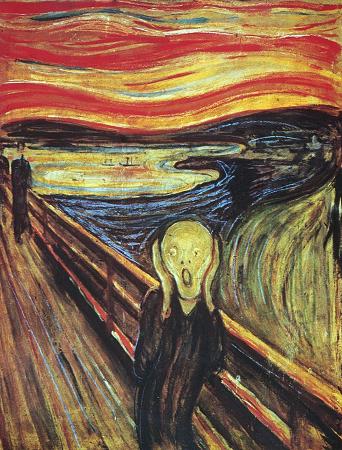Scream (1893). Crayon, tempera on cardboard. 91 x 74. The Scream is the popular name given to a composition created by Norwegian Expressionist artist Edvard Munch in 1893. The original German title given by Munch to his work was Der Schrei der Natur, and the Norwegian title is Skrik. The agonised face in the painting has become one of the most iconic images of art, seen as symbolising the anxiety of modern man. Munch recalled that he had been out for a walk at sunset when suddenly the setting sunlight turned the clouds a blood red. He sensed an infinite scream passing through nature'. Scholars have located the spot to a fjord overlooking Oslo, and have suggested other explanations for the unnaturally orange sky, ranging from the effects of a volcanic eruption to a psychological reaction by Munch to his sister's commitment at a nearby lunatic asylum. Munch created four versions in paint and pastels, as well as a lithograph stone from which several prints survive. Both of the painted versions have been stolen, but since recovered. One of the pastel versions commanded the fourth highest nominal price paid for a painting at a public auction. In his diary in an entry headed Nice 22 January 1892, Munch wrote: One evening I was walking along a path, the city was on one side and the fjord below. I felt tired and ill. I stopped and looked out over the fjord, the sun was setting, and the clouds turning blood red. I sensed a scream passing through nature; it seemed to me that I heard the scream. I painted this picture, painted the clouds as actual blood. The color shrieked. This became The Scream. He later described his inspiration for the image: I was walking along the road with two friends-the sun was setting-suddenly the sky turned blood red-I paused, feeling exhausted, and leaned on the fence-there was blood and tongues of fire above the blue-black fjord and the city-my friends walked on, and I stood there trembling with anxiety-and I sensed an infinite scream passing through nature. Among theories advanced to account for the reddish sky in the background is the artist's memory of the effects of the powerful volcanic eruption of Krakatoa, which deeply tinted sunset skies red in parts of the Western hemisphere for months during 1883 and 1884, about a decade before Munch painted The Scream. This explanation has been disputed by scholars, who note that Munch was an expressive painter and was not primarily interested in literal renderings of what he had seen. Another explanation for the red skies is that they are due to the appearance of nacreous clouds which occur at the latitude of Norway and which look remarkably similar to the skies depicted in The Scream. Alternatively, it has been suggested that the proximity of both a slaughterhouse and a lunatic asylum to the site depicted in the painting may have offered some inspiration. The scene was identified as being the view from a road overlooking Oslo, the Oslofjord and Hovedoya, from the hill of Ekeberg. At the time of painting the work, Munch's manic depressive sister Laura Catherine was a patient at the mental asylum at the foot of Ekeberg. In 1978, the Munch scholar Robert Rosenblum suggested that the strange, sexless creature in the foreground of the painting was inspired by a Peruvian mummy, which Munch could have seen at the 1889 Exposition Universelle in Paris. This mummy, which was buried in a fetal position with its hands alongside its face, also struck the imagination of Munch's friend Paul Gauguin: it stood as a model for figures in more than twenty of Gauguin's paintings, among those the central figure in his painting, Human misery and for the old woman at the left in his painting, Where Do We Come From? What Are We? Where Are We Going?. In 2004, an Italian anthropologist speculated that Munch might have seen a mummy in Florence's Museum of Natural History, which bears an even more striking resemblance to the painting. However, later studies have disputed the Italian theory, for Munch never visited Florence until after painting The Scream. The imagery of The Scream has been compared to that which an individual suffering from depersonalization disorder experiences, a feeling of distortion of the environment and one's self. Arthur Lubow has described The Scream as an icon of modern art, a Mona Lisa for our time. It has been widely interpreted as representing the universal anxiety of modern man. Munch created four versions in paint and pastels. The first painted version was the first exhibited, debuting in 1893.
more...





